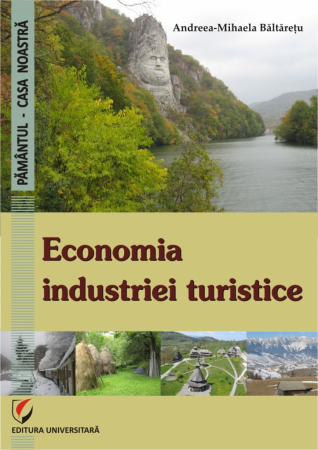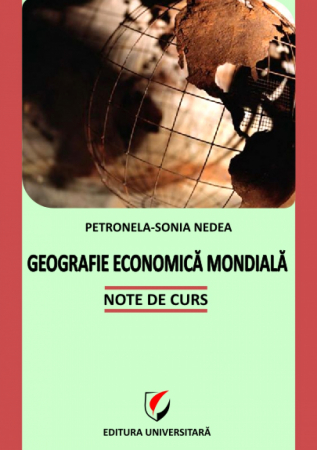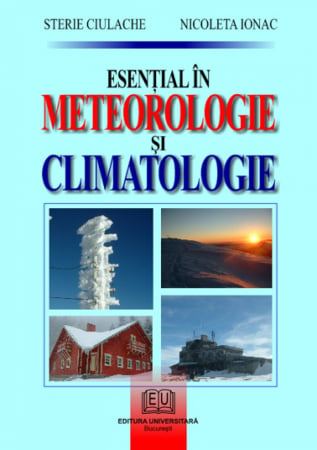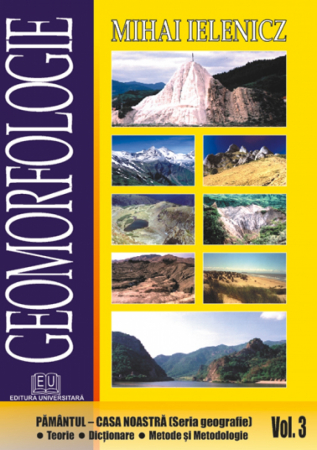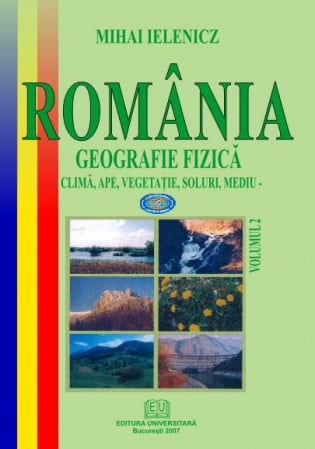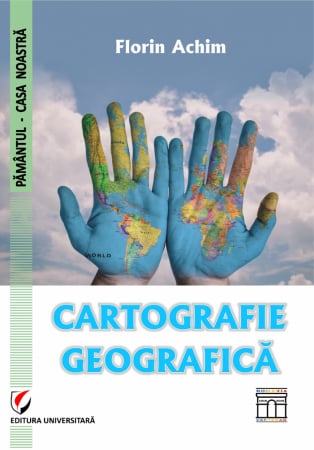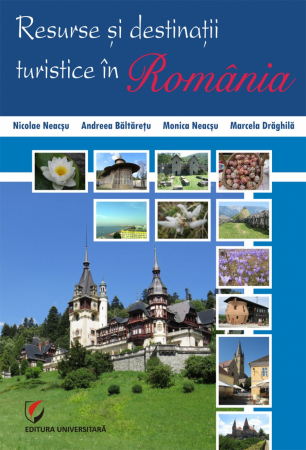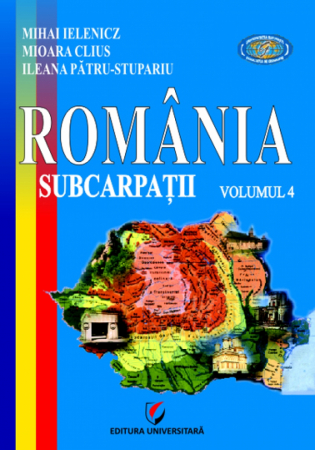Manuscript proposals: [email protected] / 0745 204 115 //// Tracking orders Individuals / Sales: 0745 200 357 / Orders Legal entities: 0721 722 783
ISBN: 978-606-28-0499-2
DOI: 10.5682/9786062804992
Publisher year: 2017
Edition: II, revizuita si adaugita
Pages: 280
Publisher: Editura Universitară
Author: George Erdeli, Liliana Dumitrache
Product Code:
9786062804992
Do you need help?
0745 200 357
- Description
- Download (1)
- Authors
- Content
- More details
- Reviews (0)
Geography studies and interprets the complexity of demographic phenomena, factors of spatial distribution of the population, demographic gaps between countries and geographical regions, depending on time and space, the concrete natural, economic and social conditions.
The informational richness, as well as the authors' points of view on the topical problems, fully contribute to the deeper and more accurate knowledge of the geodemographic problems of today's world.
The close correlation of the population geography with other scientific fields is highlighted, showing the place of the population geography within the human geography, its object of study and its development directions.
Capitalizing on a series of statistical-demographic results and approaching them geographically, special emphasis is placed on spatial and regional aspects aimed at the distribution, dynamics, mobility and structure of the world population (by age groups and sexes, socio-economic, by means of life, ethno-cultural).
In carrying out this paper we started from the idea that the study of the population in the spatio-temporal perspective does not become convincing unless it explains all the mechanisms that lead to the described situation.
Based on statistical and territorial information were analyzed: birth rate, fertility, general and infant mortality, natural growth and types of demographic evolution, by country, but also by large geographical regions, evoking the role of demographic policies and their consequences.
Relationships between young people and the elderly, as well as imbalances between different age groups, the processes of aging or demographic rejuvenation that affect different parts of the world are also widely presented.
The activities of the population were also the object of the authors' attention, showing the decline of primary activities, the heterogeneous evolution of the secondary sector, the growth of the tertiary sector or highlighting the differentiated participation of the female and male population in economic life. of today's world.
Equally highlighted are the demo-economic imbalances that tend to be blurred as a result of voluntary migration, the dire consequences of military or religious conflicts that generate waves of refugees.
Last but not least, within the ethno-cultural structure of the population, new elements regarding the racial, ethnic, religious and linguistic diversity are highlighted.
This paper could not be completed without illustrating concepts such as human development, sustainable development and eco-development, as defining forms of human life.
Also, the study, which is completed by a rich illustrative material (maps, graphs, tables), is based on an extensive documentation, consulting national or international bibliographic and statistical sources.
The addressability area of the paper is represented by students, doctoral students, teachers, scientific researchers and specialists who are interested in the problems of the population seen through a geographical perspective.
The informational richness, as well as the authors' points of view on the topical problems, fully contribute to the deeper and more accurate knowledge of the geodemographic problems of today's world.
The close correlation of the population geography with other scientific fields is highlighted, showing the place of the population geography within the human geography, its object of study and its development directions.
Capitalizing on a series of statistical-demographic results and approaching them geographically, special emphasis is placed on spatial and regional aspects aimed at the distribution, dynamics, mobility and structure of the world population (by age groups and sexes, socio-economic, by means of life, ethno-cultural).
In carrying out this paper we started from the idea that the study of the population in the spatio-temporal perspective does not become convincing unless it explains all the mechanisms that lead to the described situation.
Based on statistical and territorial information were analyzed: birth rate, fertility, general and infant mortality, natural growth and types of demographic evolution, by country, but also by large geographical regions, evoking the role of demographic policies and their consequences.
Relationships between young people and the elderly, as well as imbalances between different age groups, the processes of aging or demographic rejuvenation that affect different parts of the world are also widely presented.
The activities of the population were also the object of the authors' attention, showing the decline of primary activities, the heterogeneous evolution of the secondary sector, the growth of the tertiary sector or highlighting the differentiated participation of the female and male population in economic life. of today's world.
Equally highlighted are the demo-economic imbalances that tend to be blurred as a result of voluntary migration, the dire consequences of military or religious conflicts that generate waves of refugees.
Last but not least, within the ethno-cultural structure of the population, new elements regarding the racial, ethnic, religious and linguistic diversity are highlighted.
This paper could not be completed without illustrating concepts such as human development, sustainable development and eco-development, as defining forms of human life.
Also, the study, which is completed by a rich illustrative material (maps, graphs, tables), is based on an extensive documentation, consulting national or international bibliographic and statistical sources.
The addressability area of the paper is represented by students, doctoral students, teachers, scientific researchers and specialists who are interested in the problems of the population seen through a geographical perspective.
-
Geografia populatiei mondiale
Download
GEORGE ERDELI
LILIANA DUMITRACHE
LILIANA DUMITRACHE
PREFACE / 5
CHAPTER 1. POPULATION GEOGRAPHY. INTERDISCIPLINARITY AND OBJECT OF STUDY / / 15
1.1. THE PLACE OF POPULATION GEOGRAPHY IN HUMAN GEOGRAPHY. OBJECT, FIELD OF STUDY AND DEVELOPMENT ORIENTATIONS / 15
1.1.1. The contribution of the Romanian geographical school to the development of the population geography / 21
1.1.2. Sources of demographic information used in the study of population geography / 26
CHAPTER 2. SPATIAL DISTRIBUTION OF THE WORLD POPULATION / 30
2.1. MAJOR GEOGRAPHICAL DISPARITIES OF WORLD POPULATION DISTRIBUTION / 30
2.1.1. Unpopulated or very sparsely populated areas / 34
2.1.2. Areas of large human concentrations / 36
2.1.3. Moderately populated areas / 38
2.2. FACTORS OF THE SPATIAL DISTRIBUTION OF THE POPULATION / 38
2.2.1. The role of natural factors in the spatial distribution of the population / 39
2.2.1.1. Climate / 39
2.2.1.2. Relief / 41
2.2.2. The role of historical factors in the spatial distribution of the population / 43
2.2.2.1. The age of the population / 44
2.2.2.2. Migrations / 46
2.2.3. The role of demographic dynamism in the spatial distribution of the population / 47
2.2.4. The role of economic factors in the spatial distribution of the population / 49
2.2.4.1. Mineral and energy resources / 49
2.2.4.2. Technical progress and innovations / 50
2.3. PERSPECTIVES OF THE GEOGRAPHICAL DISTRIBUTION OF THE POPULATION / 51
CHAPTER 3. POPULATION DYNAMICS / 53
3.1. POPULATION DYNAMIC COMPONENTS / 53
3.2. NATURAL MOVEMENT / 54
3.2.1. Birth rate / 55
3.2.1.1. Factors that determine the spatial variation of the birth rate / 55
3.2.1.1.1. Economic factors / 55
3.2.1.1.2. Political factors (demographic policies) / 55
3.2.1.1.3. Socio-cultural factors / 56
3.2.1.1.3.1. The status of women in society / 56
3.2.1.1.3.2. Religion / 57
3.2.1.1.3.3. The general psychological climate / 57
3.2.1.1.4. Age of the population / 58
3.2.1.2. Spatial variations of the birth rate / 58
3.2.2. Fertility / 60
3.2.2.1. Spatial variations of fertility / 61
3.2.3. Mortality / 65
3.2.3.1. Factors that determine the spatial variation of mortality / 65
3.2.3.1.1. General level of economic development / 65
3.2.3.1.2. The health care system / 65
3.2.3.1.3. General level of education of the population / 66
3.2.3.1.4. Structure by age groups and sexes / 66
3.2.3.2. Spatial variations of mortality / 66
3.2.4. Life expectancy at birth / 69
3.2.4.1. Spatial variations of life expectancy at birth / 69
3.2.5. Infant mortality / 71
3.2.5.1. Spatial variations of infant mortality / 71
3.2.6. Natural increase (natural balance) / 72
3.2.7. Types of demographic evolution. Law on demographic transition / 74
CHAPTER 4. INCREASING THE NUMBER OF THE WORLD POPULATION / 78
4.1. INCREASING THE POPULATION NUMBER FROM THE PALEOLITHIC TO THE PRESENT / 80
4.1.1. Population growth in the Paleolithic and Mesolithic / 80
4.1.2. Demographic growth from the Neolithic to the eighteenth century / 81
4.1.3. Demographic growth in the modern and contemporary period (18th century - 20th century) / 84
4.1.3.1. The increase of the population number in the 18th century / 84
4.1.3.2. The increase of the population number in the 19th century / 85
4.1.3.3. Population growth in the twentieth century / 88
4.1.4. Perspectives of increasing the world population / 93
4.2. THEORIES REGARDING THE INCREASE OF THE POPULATION NUMBER .......... / 94
4.2.1. Theories regarding the increase of the population number from Antiquity until the 18th century / 94
4.2.2. Theories regarding the increase of the population number in the modern period / 96
4.3. POSSIBLE REMEDIES IN THE PROBLEM OF DEMOGRAPHIC GROWTH / 100
CHAPTER 5. SPATIAL MOBILITY OF THE POPULATION / 102
5.1. FACTORS THAT DETERMINE POPULATION MOBILITY / 102
5.2. FORMS OF POPULATION MOBILITY / 105
5.2.1. Ordinary population movements / 106
5.2.1.1. Ordinary travel in underdeveloped states / 109
5.2.1.2. Ordinary travel in developed countries / 109
5.2.2. The migratory movements proper / 111
5.2.2.1. Internal migrations / 112
5.2.2.1.1. Short - term or periodic migrations / 112
5.2.2.1.1.1. Seasonal migrations / 114
5.2.2.1.1.2. Temporary migrations / 114
5.2.2.1.2. Long - term or permanent internal migrations / 115
5.2.2.2. International migrations / 116
5.2.2.2.1. Types of migrants. / 118
5.2.2.2.2. The evolution of international migrations / 129
5.2.2.2.3. Migrations from the contemporary period / 132
5.2.2.2.3.1. Characteristics of migrations from the contemporary period / 132
5.2.2.2.3.2. International migrations at the end of the 20th century / 133
5.2.2.2.4. Illegal migration / 136
5.2.2.2.5. Consequences of international migration / 140
5.3. THEORIES ON MIGRATION / 141
CHAPTER 6. WORLD POPULATION STRUCTURE / 145
6.1. POPULATION STRUCTURE BY AGE AND SEX GROUPS / 145
6.1.1. Population structure by age groups / 145
6.1.1.1. Median age / 153
6.1.1.2. Consequences of demographic aging / 158
6.1.2. Population structure by the two sexes / 161
6.2. SOCIO-ECONOMIC STRUCTURE OF THE POPULATION / 163
6.2.1. World population activity rate / 164
6.2.2. Unemployment level / 168
6.2.3. Population structure according to economic activity / 168
6.2.3.1. Primary sector / 170
6.2.3.2. Secondary sector / 172
6.2.3.3. Tertiary sector / 172
6.3. POPULATION STRUCTURE BY ENVIRONMENT - RURAL / URBAN / 175
6.3.1. Urban population / 176
6.3.1.1. Spatial inequalities of urbanization / 177
6.3.1.2. The evolution of urbanization worldwide / 181
6.3.2. Rural population / 186
6.4. ETHNO-CULTURAL STRUCTURE OF THE POPULATION / 188
6.4.1. Racial structure / 188
6.4.2. Ethnic structure / 193
6.4.2.1. The role of the territory and the state in identifying ethnic harrows / 193
6.4.2.2. Types of spatial relations between nation, state and minorities / 194
6.4.2.3. Classification of minorities / 195
6.4.3. Population structure by religious denominations / 199
6.4.3.1. Classification of religions / 200
6.4.3.2. Spatial distribution of religions / 201
6.4.3.3. The current confessional area / 202
6.4.3.4. The influence of religions on the population / 205
6.4.4. Linguistic structure of the population / 205
6.4.4.1. Classification of language groups / 207
6.4.4.2. The origin and spatial distribution of linguistic harrows / 210
6.4.4.3. Language, territoriality and identity / 215
CHAPTER 7. POPULATION AND SOCIAL-ECONOMIC DEVELOPMENT / 216
7.1. THE CONCEPT OF DEVELOPMENT / UNDERDEVELOPMENT / 216
7.2. THE CONCEPT OF HUMAN DEVELOPMENT / 220
7.2.1. Human Development Index / 220
7.2.2. Trends in human development in the last decades of the twentieth century / 228
7.2.3. Human Poverty Index / 229
7.2.4. Gender-specific human development index / 231
7.3. THE CONCEPT OF SUSTAINABLE DEVELOPMENT / 232
7.4. THE CONCEPT OF ECODEVELOPMENT / 237
GLOSSARY / 241
BIBLIOGRAPHY / 265
ANNEXES / 273
CHAPTER 1. POPULATION GEOGRAPHY. INTERDISCIPLINARITY AND OBJECT OF STUDY / / 15
1.1. THE PLACE OF POPULATION GEOGRAPHY IN HUMAN GEOGRAPHY. OBJECT, FIELD OF STUDY AND DEVELOPMENT ORIENTATIONS / 15
1.1.1. The contribution of the Romanian geographical school to the development of the population geography / 21
1.1.2. Sources of demographic information used in the study of population geography / 26
CHAPTER 2. SPATIAL DISTRIBUTION OF THE WORLD POPULATION / 30
2.1. MAJOR GEOGRAPHICAL DISPARITIES OF WORLD POPULATION DISTRIBUTION / 30
2.1.1. Unpopulated or very sparsely populated areas / 34
2.1.2. Areas of large human concentrations / 36
2.1.3. Moderately populated areas / 38
2.2. FACTORS OF THE SPATIAL DISTRIBUTION OF THE POPULATION / 38
2.2.1. The role of natural factors in the spatial distribution of the population / 39
2.2.1.1. Climate / 39
2.2.1.2. Relief / 41
2.2.2. The role of historical factors in the spatial distribution of the population / 43
2.2.2.1. The age of the population / 44
2.2.2.2. Migrations / 46
2.2.3. The role of demographic dynamism in the spatial distribution of the population / 47
2.2.4. The role of economic factors in the spatial distribution of the population / 49
2.2.4.1. Mineral and energy resources / 49
2.2.4.2. Technical progress and innovations / 50
2.3. PERSPECTIVES OF THE GEOGRAPHICAL DISTRIBUTION OF THE POPULATION / 51
CHAPTER 3. POPULATION DYNAMICS / 53
3.1. POPULATION DYNAMIC COMPONENTS / 53
3.2. NATURAL MOVEMENT / 54
3.2.1. Birth rate / 55
3.2.1.1. Factors that determine the spatial variation of the birth rate / 55
3.2.1.1.1. Economic factors / 55
3.2.1.1.2. Political factors (demographic policies) / 55
3.2.1.1.3. Socio-cultural factors / 56
3.2.1.1.3.1. The status of women in society / 56
3.2.1.1.3.2. Religion / 57
3.2.1.1.3.3. The general psychological climate / 57
3.2.1.1.4. Age of the population / 58
3.2.1.2. Spatial variations of the birth rate / 58
3.2.2. Fertility / 60
3.2.2.1. Spatial variations of fertility / 61
3.2.3. Mortality / 65
3.2.3.1. Factors that determine the spatial variation of mortality / 65
3.2.3.1.1. General level of economic development / 65
3.2.3.1.2. The health care system / 65
3.2.3.1.3. General level of education of the population / 66
3.2.3.1.4. Structure by age groups and sexes / 66
3.2.3.2. Spatial variations of mortality / 66
3.2.4. Life expectancy at birth / 69
3.2.4.1. Spatial variations of life expectancy at birth / 69
3.2.5. Infant mortality / 71
3.2.5.1. Spatial variations of infant mortality / 71
3.2.6. Natural increase (natural balance) / 72
3.2.7. Types of demographic evolution. Law on demographic transition / 74
CHAPTER 4. INCREASING THE NUMBER OF THE WORLD POPULATION / 78
4.1. INCREASING THE POPULATION NUMBER FROM THE PALEOLITHIC TO THE PRESENT / 80
4.1.1. Population growth in the Paleolithic and Mesolithic / 80
4.1.2. Demographic growth from the Neolithic to the eighteenth century / 81
4.1.3. Demographic growth in the modern and contemporary period (18th century - 20th century) / 84
4.1.3.1. The increase of the population number in the 18th century / 84
4.1.3.2. The increase of the population number in the 19th century / 85
4.1.3.3. Population growth in the twentieth century / 88
4.1.4. Perspectives of increasing the world population / 93
4.2. THEORIES REGARDING THE INCREASE OF THE POPULATION NUMBER .......... / 94
4.2.1. Theories regarding the increase of the population number from Antiquity until the 18th century / 94
4.2.2. Theories regarding the increase of the population number in the modern period / 96
4.3. POSSIBLE REMEDIES IN THE PROBLEM OF DEMOGRAPHIC GROWTH / 100
CHAPTER 5. SPATIAL MOBILITY OF THE POPULATION / 102
5.1. FACTORS THAT DETERMINE POPULATION MOBILITY / 102
5.2. FORMS OF POPULATION MOBILITY / 105
5.2.1. Ordinary population movements / 106
5.2.1.1. Ordinary travel in underdeveloped states / 109
5.2.1.2. Ordinary travel in developed countries / 109
5.2.2. The migratory movements proper / 111
5.2.2.1. Internal migrations / 112
5.2.2.1.1. Short - term or periodic migrations / 112
5.2.2.1.1.1. Seasonal migrations / 114
5.2.2.1.1.2. Temporary migrations / 114
5.2.2.1.2. Long - term or permanent internal migrations / 115
5.2.2.2. International migrations / 116
5.2.2.2.1. Types of migrants. / 118
5.2.2.2.2. The evolution of international migrations / 129
5.2.2.2.3. Migrations from the contemporary period / 132
5.2.2.2.3.1. Characteristics of migrations from the contemporary period / 132
5.2.2.2.3.2. International migrations at the end of the 20th century / 133
5.2.2.2.4. Illegal migration / 136
5.2.2.2.5. Consequences of international migration / 140
5.3. THEORIES ON MIGRATION / 141
CHAPTER 6. WORLD POPULATION STRUCTURE / 145
6.1. POPULATION STRUCTURE BY AGE AND SEX GROUPS / 145
6.1.1. Population structure by age groups / 145
6.1.1.1. Median age / 153
6.1.1.2. Consequences of demographic aging / 158
6.1.2. Population structure by the two sexes / 161
6.2. SOCIO-ECONOMIC STRUCTURE OF THE POPULATION / 163
6.2.1. World population activity rate / 164
6.2.2. Unemployment level / 168
6.2.3. Population structure according to economic activity / 168
6.2.3.1. Primary sector / 170
6.2.3.2. Secondary sector / 172
6.2.3.3. Tertiary sector / 172
6.3. POPULATION STRUCTURE BY ENVIRONMENT - RURAL / URBAN / 175
6.3.1. Urban population / 176
6.3.1.1. Spatial inequalities of urbanization / 177
6.3.1.2. The evolution of urbanization worldwide / 181
6.3.2. Rural population / 186
6.4. ETHNO-CULTURAL STRUCTURE OF THE POPULATION / 188
6.4.1. Racial structure / 188
6.4.2. Ethnic structure / 193
6.4.2.1. The role of the territory and the state in identifying ethnic harrows / 193
6.4.2.2. Types of spatial relations between nation, state and minorities / 194
6.4.2.3. Classification of minorities / 195
6.4.3. Population structure by religious denominations / 199
6.4.3.1. Classification of religions / 200
6.4.3.2. Spatial distribution of religions / 201
6.4.3.3. The current confessional area / 202
6.4.3.4. The influence of religions on the population / 205
6.4.4. Linguistic structure of the population / 205
6.4.4.1. Classification of language groups / 207
6.4.4.2. The origin and spatial distribution of linguistic harrows / 210
6.4.4.3. Language, territoriality and identity / 215
CHAPTER 7. POPULATION AND SOCIAL-ECONOMIC DEVELOPMENT / 216
7.1. THE CONCEPT OF DEVELOPMENT / UNDERDEVELOPMENT / 216
7.2. THE CONCEPT OF HUMAN DEVELOPMENT / 220
7.2.1. Human Development Index / 220
7.2.2. Trends in human development in the last decades of the twentieth century / 228
7.2.3. Human Poverty Index / 229
7.2.4. Gender-specific human development index / 231
7.3. THE CONCEPT OF SUSTAINABLE DEVELOPMENT / 232
7.4. THE CONCEPT OF ECODEVELOPMENT / 237
GLOSSARY / 241
BIBLIOGRAPHY / 265
ANNEXES / 273
The work Geography of the world population represents a synthesis of the most important geodemographic aspects of the contemporary world.
Population is the fundamental element of society. The most important manifestations and achievements in the fields: economic, social, political, cultural, institutional find some of the main explanations in the population factor.
The human resource largely depends on the wealth of a nation, its power, its social and cultural achievements, its civilization in the last resort.
Vitality, dynamism, economic power, politics, the value of government systems, etc. of a society have been, are and will be related to the demographic component.
For the present and the future, the most accurate knowledge of demographic processes is of paramount importance, many scientific disciplines studying the population from different perspectives, using specific methods, techniques and tools.
Geography studies and interprets the complexity of demographic phenomena, factors of spatial distribution of the population, demographic gaps between countries and geographical regions, depending on time and space, the concrete natural, economic and social conditions.
The informational richness, as well as the authors' points of view on the topical problems, fully contribute to the deeper and more accurate knowledge of the geodemographic problems of today's world.
The close correlation of the population geography with other scientific fields is highlighted, showing the place of the population geography within the human geography, its object of study and its development directions.
Capitalizing on a series of statistical-demographic results and approaching them geographically, special emphasis is placed on spatial and regional aspects aimed at the distribution, dynamics, mobility and structure of the world population (by age groups and sexes, socio-economic, by means of life, ethno-cultural).
In carrying out this paper we started from the idea that the study of the population in the spatio-temporal perspective does not become convincing unless it explains all the mechanisms that lead to the described situation.
Based on statistical and territorial information were analyzed: birth rate, fertility, general and infant mortality, natural growth and types of demographic evolution, by country, but also by large geographical regions, evoking the role of demographic policies and their consequences.
Relationships between young people and the elderly, as well as imbalances between different age groups, the processes of aging or demographic rejuvenation that affect different parts of the world are also widely presented.
The activities of the population were also the object of the authors' attention, showing the decline of primary activities, the heterogeneous evolution of the secondary sector, the growth of the tertiary sector or highlighting the differentiated participation of the female and male population in economic life. of today's world.
Equally highlighted are the demo-economic imbalances that tend to be blurred as a result of voluntary migration, the dire consequences of military or religious conflicts that generate waves of refugees.
Last but not least, within the ethno-cultural structure of the population, new elements regarding the racial, ethnic, religious and linguistic diversity are highlighted.
This paper could not be completed without illustrating concepts such as human development, sustainable development and eco-development, as defining forms of human life.
Also, the study, which is completed by a rich illustrative material (maps, graphs, tables), is based on an extensive documentation, consulting national or international bibliographic and statistical sources.
The addressability area of the paper is represented by students, doctoral students, teachers, scientific researchers and specialists who are interested in the problems of the population seen through a geographical perspective.
The Authors
Population is the fundamental element of society. The most important manifestations and achievements in the fields: economic, social, political, cultural, institutional find some of the main explanations in the population factor.
The human resource largely depends on the wealth of a nation, its power, its social and cultural achievements, its civilization in the last resort.
Vitality, dynamism, economic power, politics, the value of government systems, etc. of a society have been, are and will be related to the demographic component.
For the present and the future, the most accurate knowledge of demographic processes is of paramount importance, many scientific disciplines studying the population from different perspectives, using specific methods, techniques and tools.
Geography studies and interprets the complexity of demographic phenomena, factors of spatial distribution of the population, demographic gaps between countries and geographical regions, depending on time and space, the concrete natural, economic and social conditions.
The informational richness, as well as the authors' points of view on the topical problems, fully contribute to the deeper and more accurate knowledge of the geodemographic problems of today's world.
The close correlation of the population geography with other scientific fields is highlighted, showing the place of the population geography within the human geography, its object of study and its development directions.
Capitalizing on a series of statistical-demographic results and approaching them geographically, special emphasis is placed on spatial and regional aspects aimed at the distribution, dynamics, mobility and structure of the world population (by age groups and sexes, socio-economic, by means of life, ethno-cultural).
In carrying out this paper we started from the idea that the study of the population in the spatio-temporal perspective does not become convincing unless it explains all the mechanisms that lead to the described situation.
Based on statistical and territorial information were analyzed: birth rate, fertility, general and infant mortality, natural growth and types of demographic evolution, by country, but also by large geographical regions, evoking the role of demographic policies and their consequences.
Relationships between young people and the elderly, as well as imbalances between different age groups, the processes of aging or demographic rejuvenation that affect different parts of the world are also widely presented.
The activities of the population were also the object of the authors' attention, showing the decline of primary activities, the heterogeneous evolution of the secondary sector, the growth of the tertiary sector or highlighting the differentiated participation of the female and male population in economic life. of today's world.
Equally highlighted are the demo-economic imbalances that tend to be blurred as a result of voluntary migration, the dire consequences of military or religious conflicts that generate waves of refugees.
Last but not least, within the ethno-cultural structure of the population, new elements regarding the racial, ethnic, religious and linguistic diversity are highlighted.
This paper could not be completed without illustrating concepts such as human development, sustainable development and eco-development, as defining forms of human life.
Also, the study, which is completed by a rich illustrative material (maps, graphs, tables), is based on an extensive documentation, consulting national or international bibliographic and statistical sources.
The addressability area of the paper is represented by students, doctoral students, teachers, scientific researchers and specialists who are interested in the problems of the population seen through a geographical perspective.
The Authors
If you want to express your opinion about this product you can add a review.
write a review

6359.png)
![Geography of the World Population - George Erdeli Liliana Dumitrache [1] Geography of the World Population - George Erdeli Liliana Dumitrache [1]](https://gomagcdn.ro/domains/editurauniversitara.ro/files/product/large/geografia-populatiei-mondiale-377-159416.jpg)

